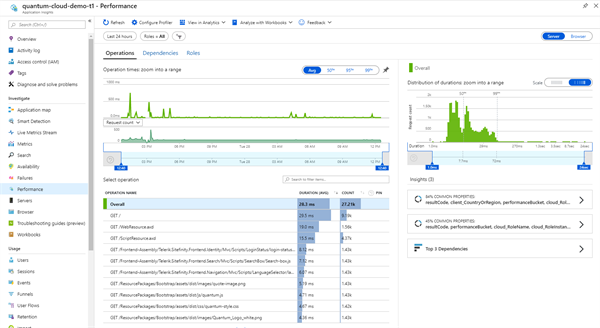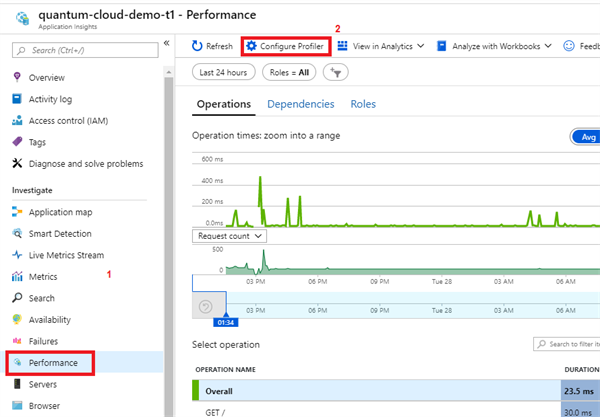Troubleshooting
Overview
Sitefinity Cloud provides easy access to the tools and resources needed to troubleshoot problems with your project. The key components that are available to allow efficient troubleshooting process are the logs, database backup, and code files.
The code of your Sitefinity Web Application is stored in a code repository in the Management Portal of Sitefinity Cloud. This provides an interface for developers to see what code is currently deployed and download it locally to troubleshoot any issues or implement new functionality. For more information see Setup the project for development.
Your project database is backed up on regular intervals, and you can also create on-demand backups. You can use these backups to restore a local copy of the project database. For more information see Backup and restore the project database.
Logs
Sitefinity Cloud provides comprehensive logging to assist website administrators and developers in troubleshoot any issues, as well as monitoring the health of the application. By default, Sitefinity Cloud exposes the following logs:
- Build & Deployment logs
They indicate the state of the application build & deployment processes.
You can view these logs by clicking on the CI.CD pipeline in your Sitefinity Cloud project's Pipelines section.
- Sitefinity logs
These are all Sitefinity logs, such as Error.log and Trace.log.
You can access them from the Management Portal of your Sitefinity Cloud project.
View the logs
To open your Sitefinity Cloud project logs and drill down in the application health data, perform the following:
- Open the Management portal Welcome page.
- In the Environments section, click the View Logs link of the desired environment.
The Logs page opens. In the left navigation, the page displays a collection of predefined logs for your application such as:
- traces
This log aggregates the information from all system logs, except for the IIS Event Log and all Sitefinity CMS traces. In this log you can find tracing information about the application performance and any handled exceptions.
- exceptions
This log aggregates the IIS Event Log and Sitefinity CMS logs. In this log you can find IIS error, warning, and information events data, as well as any unhandled exceptions, usually logged in the on-premise versions of Sitefinity CMS log files.
- To view the entries inside any log, hover over the log and click Preview data.
- In the Query explorer, you can see different log entries by clicking a query entry and running it.
There are predefined query sets - Sitefinity logs filtered by log type. Using these queries, you can access Sitefinity CMS logs by log type - ErrorLog, Trace, Authentication, etc.
Query the logs information
By default, when you view a log you are presented with the latest 50 entries in it. Since the Sitefinity Cloud logs are based on Azure Monitor Log Analytics, you can build complex queries with the information contained in each log. This way developers and website administrators can easily find the information relevant to them, as well as implement custom logic for observing the entries they are interested in.
For more information on the query syntax and advanced capabilities, see Get started with Azure Monitor Log Analytics.
Diagnose performance
By default, your Sitefinity Cloud project has a performance profiler enabled in auto mode. This means that the profiler automatically collects data in the background on certain intervals without imposing an extra overhead on your application performance.
You can view, drill down, and analyze the collected profiler data by going to the Performance tab of your Sitefinity Cloud project Application Insights in the Microsoft Azure portal:

The profiler is based on the Microsoft Azure App Insights profiler, and automatically collects data about your application components such as server-side operations, client-side operations, page views, and so on.
Profile performance on demand
By default the performance profiler collects data on certain intervals as determined by the Azure default logic. If you wan to profile your application on-demand, you can manually enable the performance profiler and monitor the results while browsing the parts of your application, whose performance you want to measure. To enable the performance profiler follow these steps:
- From your Sitefinity Cloud Management Portal Dashboard, click the Logs link for the desired environment
- Once the App Insights page for your project opens, click on Performance in the left-hand navigation
- From the top navigation click on Configure profiler

- On the next screen click on the Profile now button
As a result the profiler is enabled an you can monitor the ongoing sessions as you browse your Sitefinity Cloud project. The profiler will run for a few minutes until it collects sufficient data.
Review the deployment package
Sitefinity Cloud is configured in continuous delivery and integration (CI/CD) setup, in accordance with Sitefinity website development best practices and the Microsoft Azure services that are being used.
On each commit to the master branch, the CI/CD pipeline produces a deployment that is automatically deployed on the Staging environment.
In some cases, developers do not include all of the required files in their Visual Studio project. In such cases, these files are not included in the build process and, thus, in the deployment package.
You can check the content of the deployment package in the following way:
- In Sitefinity Cloud Management Portal, navigate to Pipelines » Pipelines.
- Click the CI.CD pipeline.
- Click the desired deployed release.
The deployment stages appear.
- Under the CI stage, click on the <Number> artifacts link.
The list of artifacts for the CI stage opens.
- Expand the
drop folder.
In case of a partial deployment - the partial-drop folder.
- Download the
DeploymentPackage.zip.
In case of a partial deployment - the PartialDeploymentPackage.zip package.
This is the package that is deployed on all the environments by the deployment process. Only the configurations differentiate between the environments.
For more information, see Manage the configurations.
- Extract the files from the
.zip file and ensure that all required files are included in the deployment package.
NOTE: Besides checking the files in the package, sometimes it is useful to set up this deployment package locally and troubleshoot any functionality that is not working after deployment.
For more information, see Download the project for development » Set up the project code locally.
Additional troubleshooting resources
Sitefinity Cloud is integrated with Azure App Insights, thus delivering all available troubleshooting tools and mechanisms. For more information see What is Application Insights.
For example, you can use the Live Metrics Stream to monitor real-time data about your website incoming and outgoing requests, as well as CPU utilization, memory consumption and exception rate. For more information about using Live Metrics Stream see Live Metrics Stream: Monitor & Diagnose with 1-second latency.